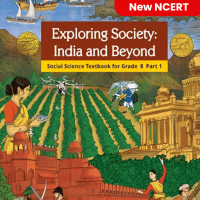Class 8 Exam > Class 8 Questions > Identify the value of persistence of vision.a...
Start Learning for Free
Identify the value of persistence of vision.
- a)1/1 0th of a second
- b)1/12th of a second
- c)1/16th of a second
- d)1/20th of a second
Correct answer is option 'C'. Can you explain this answer?
Verified Answer
Identify the value of persistence of vision.a)1/1 0th of a secondb)1/1...
Persistence of vision is a phenomenon where the brain continues to sense the image even after the object has been removed. This lasts for 1/16th of a second.
Most Upvoted Answer
Identify the value of persistence of vision.a)1/1 0th of a secondb)1/1...
Understanding Persistence of Vision
Persistence of vision is a phenomenon that allows us to perceive motion in a series of still images. It plays a crucial role in how we experience animation and video.
Definition
- Persistence of vision refers to the optical illusion where the human eye retains an image for a fraction of a second after the source has changed.
- This ability helps create the illusion of motion when images are displayed in quick succession.
Duration of Persistence of Vision
- The commonly accepted duration for persistence of vision is approximately 1/16th of a second.
- This means that if a series of images are shown within this timeframe, they can be perceived as continuous movement rather than a series of still frames.
Importance in Media
- This concept is foundational in animation and film, where frames are played rapidly (typically 24 frames per second in cinema).
- By using persistence of vision, filmmakers can create smooth visual narratives that engage viewers.
Correct Answer Explanation
- Among the options given, the correct answer is c) 1/16th of a second.
- This time frame is crucial for ensuring that our brains process the images as fluid motion, rather than as individual frames.
Conclusion
- Understanding persistence of vision enriches our appreciation for visual media and its underlying mechanics.
- It explains why animations and movies feel seamless, drawing viewers into the story being told.
Persistence of vision is a phenomenon that allows us to perceive motion in a series of still images. It plays a crucial role in how we experience animation and video.
Definition
- Persistence of vision refers to the optical illusion where the human eye retains an image for a fraction of a second after the source has changed.
- This ability helps create the illusion of motion when images are displayed in quick succession.
Duration of Persistence of Vision
- The commonly accepted duration for persistence of vision is approximately 1/16th of a second.
- This means that if a series of images are shown within this timeframe, they can be perceived as continuous movement rather than a series of still frames.
Importance in Media
- This concept is foundational in animation and film, where frames are played rapidly (typically 24 frames per second in cinema).
- By using persistence of vision, filmmakers can create smooth visual narratives that engage viewers.
Correct Answer Explanation
- Among the options given, the correct answer is c) 1/16th of a second.
- This time frame is crucial for ensuring that our brains process the images as fluid motion, rather than as individual frames.
Conclusion
- Understanding persistence of vision enriches our appreciation for visual media and its underlying mechanics.
- It explains why animations and movies feel seamless, drawing viewers into the story being told.

|
Explore Courses for Class 8 exam
|

|
Question Description
Identify the value of persistence of vision.a)1/1 0th of a secondb)1/12th of a secondc)1/16th of a secondd)1/20th of a secondCorrect answer is option 'C'. Can you explain this answer? for Class 8 2025 is part of Class 8 preparation. The Question and answers have been prepared according to the Class 8 exam syllabus. Information about Identify the value of persistence of vision.a)1/1 0th of a secondb)1/12th of a secondc)1/16th of a secondd)1/20th of a secondCorrect answer is option 'C'. Can you explain this answer? covers all topics & solutions for Class 8 2025 Exam. Find important definitions, questions, meanings, examples, exercises and tests below for Identify the value of persistence of vision.a)1/1 0th of a secondb)1/12th of a secondc)1/16th of a secondd)1/20th of a secondCorrect answer is option 'C'. Can you explain this answer?.
Identify the value of persistence of vision.a)1/1 0th of a secondb)1/12th of a secondc)1/16th of a secondd)1/20th of a secondCorrect answer is option 'C'. Can you explain this answer? for Class 8 2025 is part of Class 8 preparation. The Question and answers have been prepared according to the Class 8 exam syllabus. Information about Identify the value of persistence of vision.a)1/1 0th of a secondb)1/12th of a secondc)1/16th of a secondd)1/20th of a secondCorrect answer is option 'C'. Can you explain this answer? covers all topics & solutions for Class 8 2025 Exam. Find important definitions, questions, meanings, examples, exercises and tests below for Identify the value of persistence of vision.a)1/1 0th of a secondb)1/12th of a secondc)1/16th of a secondd)1/20th of a secondCorrect answer is option 'C'. Can you explain this answer?.
Solutions for Identify the value of persistence of vision.a)1/1 0th of a secondb)1/12th of a secondc)1/16th of a secondd)1/20th of a secondCorrect answer is option 'C'. Can you explain this answer? in English & in Hindi are available as part of our courses for Class 8.
Download more important topics, notes, lectures and mock test series for Class 8 Exam by signing up for free.
Here you can find the meaning of Identify the value of persistence of vision.a)1/1 0th of a secondb)1/12th of a secondc)1/16th of a secondd)1/20th of a secondCorrect answer is option 'C'. Can you explain this answer? defined & explained in the simplest way possible. Besides giving the explanation of
Identify the value of persistence of vision.a)1/1 0th of a secondb)1/12th of a secondc)1/16th of a secondd)1/20th of a secondCorrect answer is option 'C'. Can you explain this answer?, a detailed solution for Identify the value of persistence of vision.a)1/1 0th of a secondb)1/12th of a secondc)1/16th of a secondd)1/20th of a secondCorrect answer is option 'C'. Can you explain this answer? has been provided alongside types of Identify the value of persistence of vision.a)1/1 0th of a secondb)1/12th of a secondc)1/16th of a secondd)1/20th of a secondCorrect answer is option 'C'. Can you explain this answer? theory, EduRev gives you an
ample number of questions to practice Identify the value of persistence of vision.a)1/1 0th of a secondb)1/12th of a secondc)1/16th of a secondd)1/20th of a secondCorrect answer is option 'C'. Can you explain this answer? tests, examples and also practice Class 8 tests.

|
Explore Courses for Class 8 exam
|

|
Signup for Free!
Signup to see your scores go up within 7 days! Learn & Practice with 1000+ FREE Notes, Videos & Tests.


















